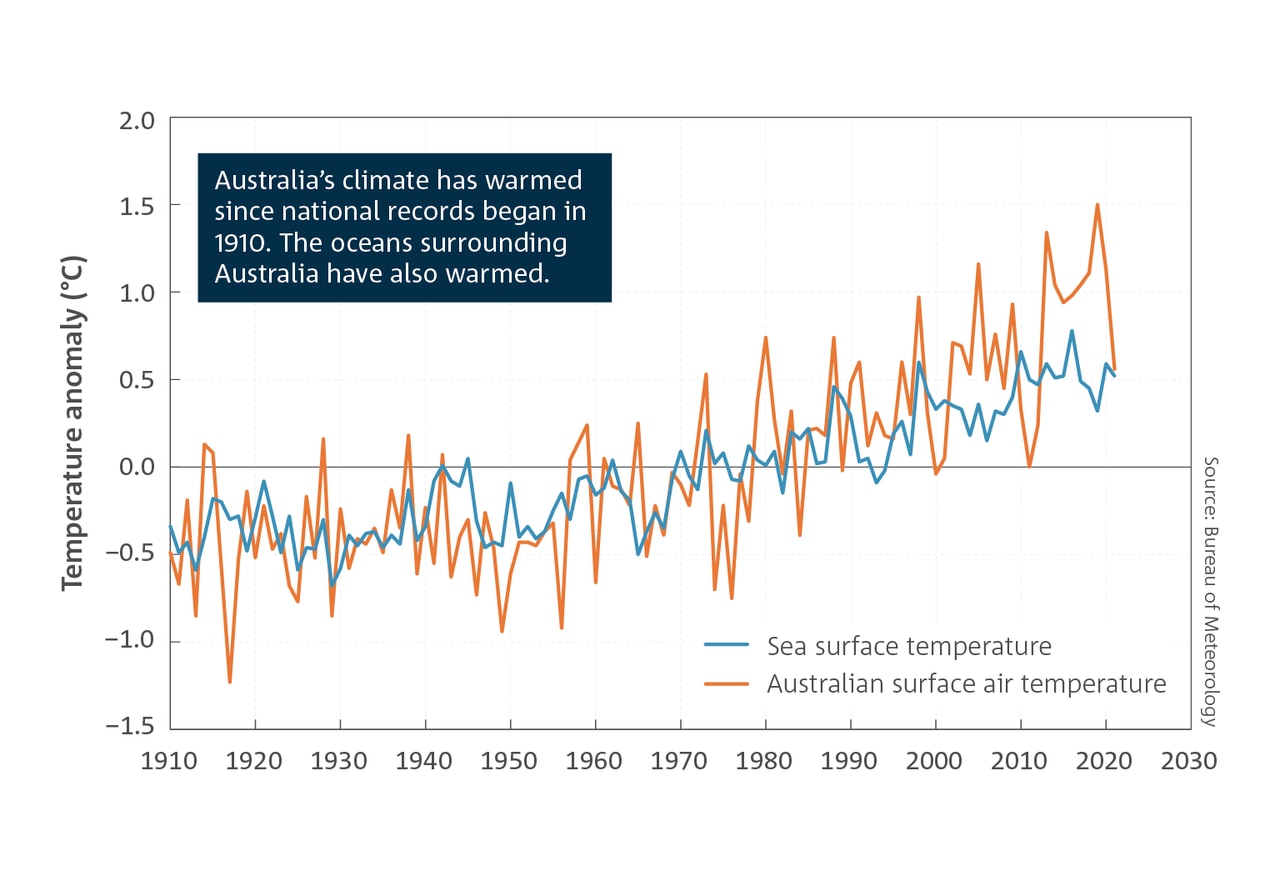Australia 1.47C warmer than 100 years ago, climate report reveals
Our nation is 1.47C hotter than it was just over 100 years, putting our temperature increase ahead of the global average, the latest climate report reveals

READING LEVEL: GREEN
Australia is 1.47C hotter today than it was just over 100 years ago, putting it ahead of the global trend* of 1.1C of warming, the latest State of the Climate report reveals.
The report, from the Bureau of Meteorology and CSIRO, reveals Australia is warmer than when national records began in 1910, though there is a margin of error* of 0.24C.
Most of the increase in warming has taken place since 1950 – and every decade since has been warmer than the previous one, the report states.
Australia’s warming trend was seen across all months of the year, in both day time and night time temperatures. And there was a clearly noticeable increase in the number of extremely hot days.
In 2019 – Australia’s hottest year on record – there were 41 extremely warm days, which the report says is “about triple the highest number in any year prior to 2000”.

While the temperature trend for the nation has been uniform, the results for rainfall are more mixed.
Rainfall in the nation’s southwest has declined since 1970 (with decreases of about 15 per cent between April and October) but it has increased in northern Australia.
Bureau of Meteorology senior climatologist Dr Lynette Bettio said that despite this past year of heavy flooding, the country was “projected* to spend more time in drought in future”.

Dr Bettio said levels of methane and nitrous oxide in Australia’s atmosphere was an area of concern.
The concentration* of those two greenhouse gases had a “noticeably rapid increase” in the past two years and it was an “active area of research,” Dr Bettio said.
Methane is emitted* during the production and transport of coal, natural gas and oil. It also results from livestock and other agricultural practices, land use and by the decay* of organic waste in rubbish tips.
Nitrous oxide is emitted during agricultural, land use and industrial activities, as well as the burning of fossil fuels and the treatment of wastewater.
Other worrying results in the biennial* report, released on November 23, include the rise in sea level – up 25cm since 1880 – and a very large decrease in the strength of our rivers, with 60 per cent of hydrologic* reference stations show a declining trend in stream flow.

The nation has also seen a decrease in the number of tropical cyclones, while in the alpine regions, snow depth, snow cover and the number of snow days have all declined.
Federal Environment Minister Tanya Plibersek described the State of the Climate report as “sobering* reading”.
“Australia is experiencing climate change now, with impacts being felt by many communities, ecosystems* and industry sectors,” she said.
“For our environment, for our communities, this report reinforces the urgent need for climate action.”
GLOSSARY
- trend: a general development or change in direction
- margin of error: the small amount that is allowed for in calculations and data collection
- projected: predicted or estimated based on information that is already known
- concentration: the amount of something in a particular area
- emitted: produced and released or discharged
- decay: the process of rotting or decomposing
- biennial: happening once every two years
- hydrologic: to do with the study of water
- sobering: making a situation seem serious, a bit worrying and worth thinking about
- ecosystems: groups of living things that live and interact with each other in a specific environment
- reinforces: strengthens or supports an existing feeling, idea or habit
EXTRA READING
Waste pyramid zeros in on plastics problem
Great Barrier Reef’s summer of bleach grief
Global warming threat to outdoor sport
Climate change: what it means for Australians
QUICK QUIZ
- How much hotter is Australia now compared to almost 100 years ago?
- What is the name of the climate report that was released on November 23?
- Which two organisations produced this report?
- Which two greenhouse gases are causing concern?
- How much has the sea level risen since 1880?
LISTEN TO THIS STORY
CLASSROOM ACTIVITIES
1. Accessing prior knowledge
To best understand texts we read, we need to think beyond just what is in the text and consider our “prior knowledge” (what we already know about a topic).
This news story tells us a lot about how the Australian climate is changing but doesn’t go into a lot of detail about why, the impacts of the changes or what we can do about it.
Work with a partner to brainstorm and jot down all of the things you already know about this topic and together discuss how this prior knowledge helps you better understand the text.
Time: allow 25 minutes to complete this activity
Curriculum Links: English; Science; Geography; Sustainability
2. Extension
Create a poster, video or song to encourage others to take action against climate change.
Time: allow 30 minutes to complete this activity
Curriculum Links: English; Sustainability
VCOP ACTIVITY
Wow word recycle
There are plenty of wow words (ambitious pieces of vocabulary) being used in the article. Some are in the glossary, but there might be extra ones from the article that you think are exceptional as well.
Identify all the words in the article that you think are not common words, and particularly good choices for the writer to have chosen.
Select three words you have highlighted to recycle into your own sentences.
If any of the words you identified are not in the glossary, write up your own glossary for them.

